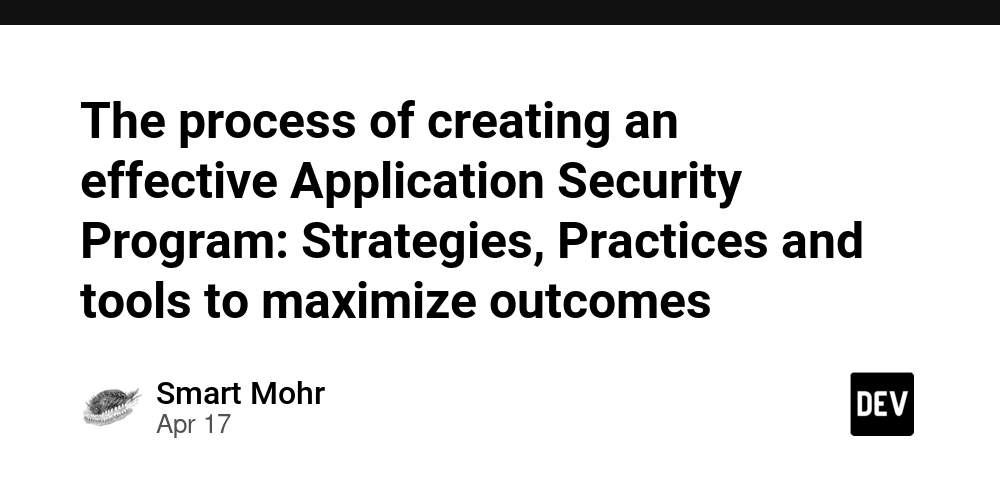The process of creating an effective Application Security Program: Strategies, Practices and tools to maximize outcomes
AppSec is a multifaceted, robust method that goes beyond simple vulnerability scanning and remediation. A holistic, proactive approach is needed to incorporate security into every stage of development. The constantly changing threat landscape and the increasing complexity of software architectures are driving the need for a proactive, holistic approach. This comprehensive guide will help you understand the most important components, best practices and cutting-edge technology that support an extremely efficient AppSec programme. It helps organizations strengthen their software assets, mitigate risks and foster a security-first culture. A successful AppSec program is built on a fundamental change of mindset. Security must be considered as an integral component of the process of development, not an afterthought. This fundamental shift in perspective requires a close partnership between security, developers operations, and other personnel. It reduces the gap between departments that hinder communication, creates a sense sharing responsibility, and encourages an open approach to the security of apps that are developed, deployed or maintain. When adopting an DevSecOps method, organizations can integrate security into the fabric of their development processes, ensuring that security considerations are addressed from the early stages of concept and design all the way to deployment and ongoing maintenance. This method of collaboration relies on the development of security standards and guidelines which offer a framework for secure coding, threat modeling and vulnerability management. These guidelines must be based on industry-standard practices like the OWASP top ten, NIST guidelines and the CWE. They must also take into consideration the distinct requirements and risk specific to an organization's application and business context. These policies should be codified and easily accessible to everyone, so that organizations can use a common, uniform security approach across their entire collection of applications. To operationalize these policies and to make them applicable for development teams, it is essential to invest in comprehensive security training and education programs. These initiatives should aim to provide developers with the know-how and expertise required to write secure code, identify vulnerable areas, and apply best practices for security throughout the development process. Training should cover a range of topics, including secure coding and common attack vectors as well as threat modeling and secure architectural design principles. By promoting a culture that encourages continuous learning and providing developers with the equipment and tools they need to build security into their daily work, companies can create a strong base for an effective AppSec program. In addition to educating employees companies must also establish secure security testing and verification procedures to detect and fix weaknesses before they are exploited by criminals. This calls for a multi-layered strategy that encompasses both static and dynamic analysis techniques along with manual penetration testing and code reviews. At the beginning of the development process static Application Security Testing tools (SAST) are a great tool to detect vulnerabilities like SQL Injection, cross-site scripting (XSS) and buffer overflows. Dynamic Application Security Testing (DAST) tools, on the other hand can be used to simulate attacks against running software, and identify vulnerabilities that might not be detected through static analysis alone. While these automated testing tools are essential to identify potential vulnerabilities at scale, they are not a panacea. Manual penetration testing conducted by security professionals is essential to uncovering complex business logic-related vulnerabilities that automated tools could miss. Combining automated testing and manual validation, businesses can get a greater understanding of their application's security status and prioritize remediation efforts based on the impact and severity of the vulnerabilities identified. To enhance the efficiency of an AppSec program, companies should look into leveraging advanced technologies such as artificial intelligence (AI) and machine learning (ML) to improve their security testing and vulnerability management capabilities. ai vulnerability management AI-powered tools can analyse huge quantities of application and code data, and identify patterns and anomalies that could be a sign of security concerns. These tools can also improve their detection and preventance of emerging threats by learning from vulnerabilities that have been exploited and previous attacks patterns. One particularly promising application of AI within AppSec is using code property graphs (CPGs) to provide more accurate and efficient vulnerability identification and remediation. CPGs provide a rich and visual representation of the application's codebase. They capture not only

AppSec is a multifaceted, robust method that goes beyond simple vulnerability scanning and remediation. A holistic, proactive approach is needed to incorporate security into every stage of development. The constantly changing threat landscape and the increasing complexity of software architectures are driving the need for a proactive, holistic approach. This comprehensive guide will help you understand the most important components, best practices and cutting-edge technology that support an extremely efficient AppSec programme. It helps organizations strengthen their software assets, mitigate risks and foster a security-first culture.
A successful AppSec program is built on a fundamental change of mindset. Security must be considered as an integral component of the process of development, not an afterthought. This fundamental shift in perspective requires a close partnership between security, developers operations, and other personnel. It reduces the gap between departments that hinder communication, creates a sense sharing responsibility, and encourages an open approach to the security of apps that are developed, deployed or maintain. When adopting an DevSecOps method, organizations can integrate security into the fabric of their development processes, ensuring that security considerations are addressed from the early stages of concept and design all the way to deployment and ongoing maintenance.
This method of collaboration relies on the development of security standards and guidelines which offer a framework for secure coding, threat modeling and vulnerability management. These guidelines must be based on industry-standard practices like the OWASP top ten, NIST guidelines and the CWE. They must also take into consideration the distinct requirements and risk specific to an organization's application and business context. These policies should be codified and easily accessible to everyone, so that organizations can use a common, uniform security approach across their entire collection of applications.
To operationalize these policies and to make them applicable for development teams, it is essential to invest in comprehensive security training and education programs. These initiatives should aim to provide developers with the know-how and expertise required to write secure code, identify vulnerable areas, and apply best practices for security throughout the development process. Training should cover a range of topics, including secure coding and common attack vectors as well as threat modeling and secure architectural design principles. By promoting a culture that encourages continuous learning and providing developers with the equipment and tools they need to build security into their daily work, companies can create a strong base for an effective AppSec program.
In addition to educating employees companies must also establish secure security testing and verification procedures to detect and fix weaknesses before they are exploited by criminals. This calls for a multi-layered strategy that encompasses both static and dynamic analysis techniques along with manual penetration testing and code reviews. At the beginning of the development process static Application Security Testing tools (SAST) are a great tool to detect vulnerabilities like SQL Injection, cross-site scripting (XSS) and buffer overflows. Dynamic Application Security Testing (DAST) tools, on the other hand can be used to simulate attacks against running software, and identify vulnerabilities that might not be detected through static analysis alone.
While these automated testing tools are essential to identify potential vulnerabilities at scale, they are not a panacea. Manual penetration testing conducted by security professionals is essential to uncovering complex business logic-related vulnerabilities that automated tools could miss. Combining automated testing and manual validation, businesses can get a greater understanding of their application's security status and prioritize remediation efforts based on the impact and severity of the vulnerabilities identified.
To enhance the efficiency of an AppSec program, companies should look into leveraging advanced technologies such as artificial intelligence (AI) and machine learning (ML) to improve their security testing and vulnerability management capabilities. ai vulnerability management AI-powered tools can analyse huge quantities of application and code data, and identify patterns and anomalies that could be a sign of security concerns. These tools can also improve their detection and preventance of emerging threats by learning from vulnerabilities that have been exploited and previous attacks patterns.
One particularly promising application of AI within AppSec is using code property graphs (CPGs) to provide more accurate and efficient vulnerability identification and remediation. CPGs provide a rich and visual representation of the application's codebase. They capture not only the syntactic structure of the code but as well the intricate interactions and dependencies that exist between the various components. AI-driven software that makes use of CPGs can perform a context-aware, deep analysis of the security of an application, and identify vulnerabilities which may have been missed by traditional static analysis.
CPGs can automate vulnerability remediation by using AI-powered techniques for repair and transformation of code. AI algorithms can produce targeted, contextual solutions by analyzing the semantics and nature of identified vulnerabilities. This permits them to tackle the root cause of an issue, rather than just treating the symptoms. This technique not only speeds up the remediation but also reduces any possibility of breaking functionality, or introducing new vulnerabilities.
Integration of security testing and validating in the continuous integration/continuous deployment (CI/CD), pipeline is an additional element of a highly effective AppSec. Automating security checks and integrating them into the build-and-deployment process allows organizations to spot weaknesses early and stop them from affecting production environments. The shift-left approach to security provides more efficient feedback loops and decreases the time and effort needed to discover and fix vulnerabilities.
In order for organizations to reach this level, they must put money into the right tools and infrastructure to help support their AppSec programs. Not only should these tools be utilized for security testing however, the platforms and frameworks which allow integration and automation. Containerization technologies such as Docker and Kubernetes can play a crucial role in this regard, providing a consistent, reproducible environment for conducting security tests, and separating the components that could be vulnerable.
Effective collaboration and communication tools are as crucial as technology tools to create the right environment for safety and helping teams work efficiently in tandem. how to use ai in application security Jira and GitLab are issue tracking systems that help teams to manage and prioritize security vulnerabilities. Tools for messaging and chat such as Slack and Microsoft Teams facilitate real-time knowledge sharing and collaboration between security experts.
In the end, the effectiveness of the success of an AppSec program is not just on the tools and techniques employed, but also the process and people that are behind the program. Building a strong, security-focused environment requires the leadership's support along with clear communication and a commitment to continuous improvement. Companies can create an environment where security is not just a checkbox to check, but rather an integral aspect of growth by fostering a sense of responsibility engaging in dialogue and collaboration by providing support and resources and creating a culture where security is an obligation shared by all.
In order to ensure the effectiveness of their AppSec program, companies should also be focused on developing meaningful metrics and key performance indicators (KPIs) to monitor their progress as well as identify areas to improve. These metrics should be able to span all phases of the application lifecycle that includes everything from the number of vulnerabilities discovered during the development phase through to the time taken to remediate issues and the overall security posture of production applications. These metrics are a way to prove the benefits of AppSec investment, to identify trends and patterns, and help organizations make an informed decision regarding where to focus on their efforts.
To keep pace with the constantly changing threat landscape and new practices, businesses should be engaged in ongoing learning and education. automated threat analysis Attending industry events or online courses, or working with experts in security and research from outside can help you stay up-to-date on the newest trends. Through fostering a continuous education culture, organizations can make sure that their AppSec program is able to be adapted and resistant to the new threats and challenges.
It is also crucial to recognize that application security is not a one-time effort it is an ongoing process that requires constant dedication and investments. The organizations must continuously review their AppSec plan to ensure it remains efficient and in line to their business objectives as new technologies and development methods emerge. Through adopting a continuous improvement mindset, promoting collaboration and communication, as well as using advanced technologies like CPGs and AI organisations can build an efficient and flexible AppSec programme that will not only secure their software assets, but enable them to innovate in a constantly changing digital environment.
automated threat analysis




























![[Webinar] AI Is Already Inside Your SaaS Stack — Learn How to Prevent the Next Silent Breach](https://blogger.googleusercontent.com/img/b/R29vZ2xl/AVvXsEiOWn65wd33dg2uO99NrtKbpYLfcepwOLidQDMls0HXKlA91k6HURluRA4WXgJRAZldEe1VReMQZyyYt1PgnoAn5JPpILsWlXIzmrBSs_TBoyPwO7hZrWouBg2-O3mdeoeSGY-l9_bsZB7vbpKjTSvG93zNytjxgTaMPqo9iq9Z5pGa05CJOs9uXpwHFT4/s1600/ai-cyber.jpg?#)














































































































































![[The AI Show Episode 144]: ChatGPT’s New Memory, Shopify CEO’s Leaked “AI First” Memo, Google Cloud Next Releases, o3 and o4-mini Coming Soon & Llama 4’s Rocky Launch](https://www.marketingaiinstitute.com/hubfs/ep%20144%20cover.png)




































































































































































































![Rogue Company Elite tier list of best characters [April 2025]](https://media.pocketgamer.com/artwork/na-33136-1657102075/rogue-company-ios-android-tier-cover.jpg?#)







































































_Andreas_Prott_Alamy.jpg?width=1280&auto=webp&quality=80&disable=upscale#)





























































































![What’s new in Android’s April 2025 Google System Updates [U: 4/18]](https://i0.wp.com/9to5google.com/wp-content/uploads/sites/4/2025/01/google-play-services-3.jpg?resize=1200%2C628&quality=82&strip=all&ssl=1)










![Apple Watch Series 10 Back On Sale for $299! [Lowest Price Ever]](https://www.iclarified.com/images/news/96657/96657/96657-640.jpg)
![EU Postpones Apple App Store Fines Amid Tariff Negotiations [Report]](https://www.iclarified.com/images/news/97068/97068/97068-640.jpg)
![Apple Slips to Fifth in China's Smartphone Market with 9% Decline [Report]](https://www.iclarified.com/images/news/97065/97065/97065-640.jpg)

































































































































